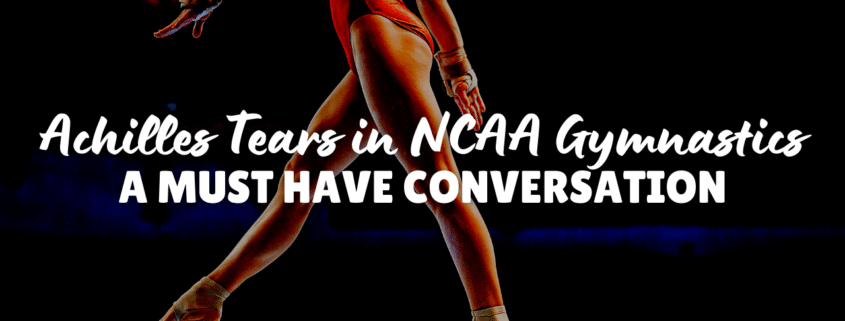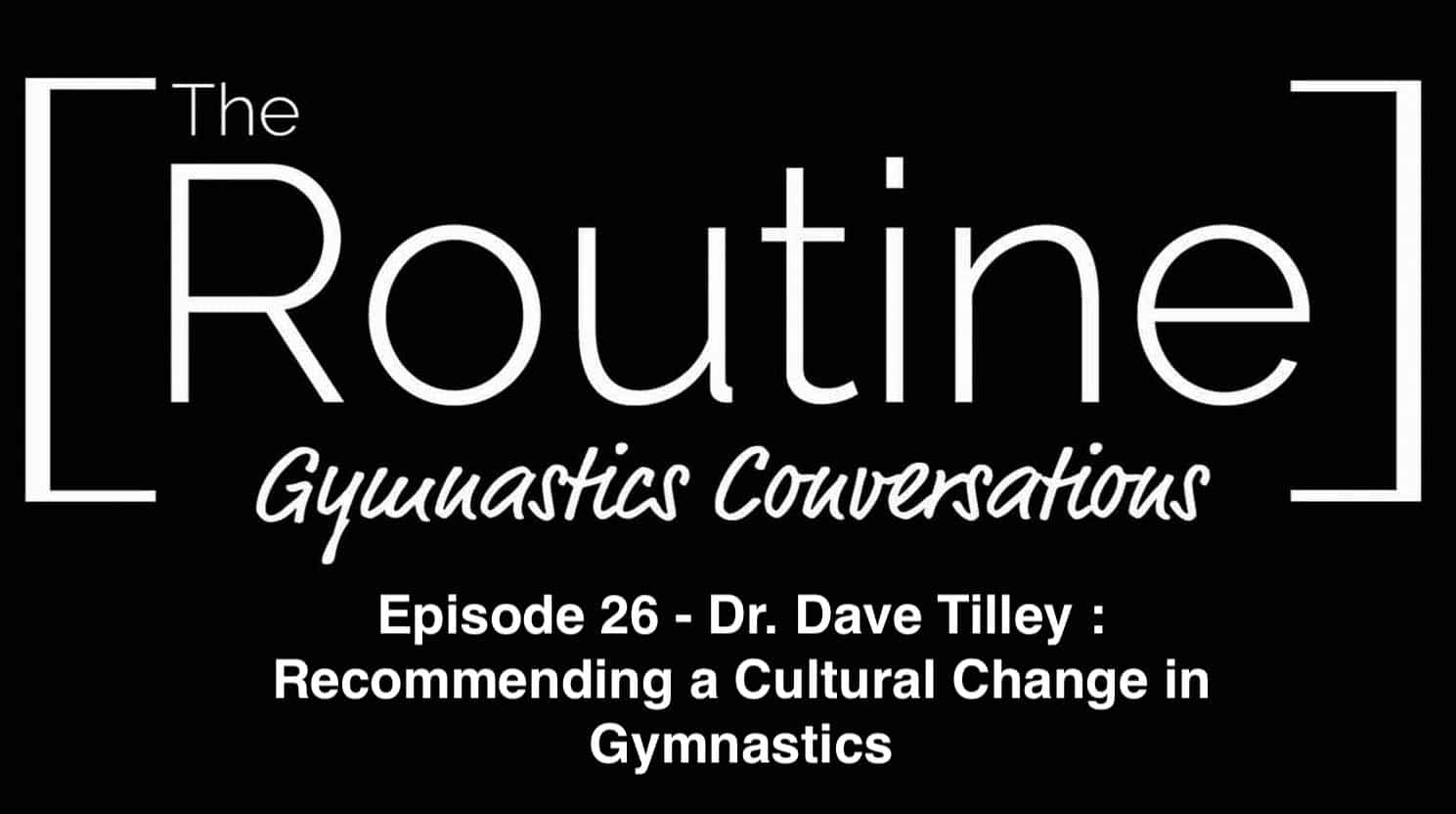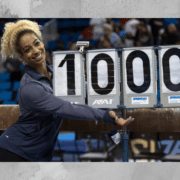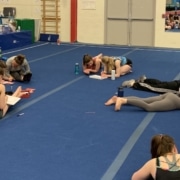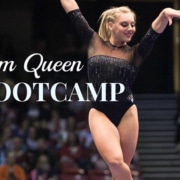Achilles Tears in NCAA Gymnastics – A Must Have Conversation
Today on the podcast, we had a little bit of an emergency shuffling of the podcasts as I felt this one really needed to go out.
Obviously, there is a huge issue with Achilles tears in NCAA women’s gymnastics and this is a problem that has been going on for the last four to five seasons.
Before COVID in 2018, there were about 20 Achilles tears in the first couple of months of the season, which was absolutely devastating to watch. Now as I’m writing this blog post in 2022, we are just a month into the season and again are seeing a massive spike in Achilles tears.
Since 2018, I have been involved in a ton of work trying to understand and figure out how to help stop so many Achilles tears from happening.
We started a research study in 2018 surveying NCAA gymnasts who tore their Achilles that got published last year in Sports Health, I wrote a monster blog breaking Achilles Tear research and talked with a world-leading expert on tendon injuries to get her thoughts.
Due to the continued high rate of Achilles tears in Women’s NCAA gymnastics, and some updates that have occurred with our research, I wanted to put out another very important lecture for free so people in gymnastics can understand some of the main issues we face.
The lecture below actually is one that I gave to all of the NCAA College Gymnastics Coaches last year when our research paper on Achilles studies, Achilles tears, and NCAA Gymnastics was being published.
I wasn’t able to share this as a podcast because we had not yet published our paper, but now that it’s out, and many people have read it and have talked about it, I can share this lecture.
I actually re-recorded it and spent an uncomfortable amount of time updating the slides and adjusting this lecture because I think that we really need to be able to look at the evidence and the science from a good point of view and take practical applications.
I also don’t want people to jump to conclusions about what we do know and what we don’t know, about Achilles tears in NCAA women’s gymnastics. Honestly, there are some large gaps in the literature, which I’ll explain in the podcast.
This lecture gives an outline of my ideas, shares conversations with world experts on Achilles’ tendons, and summarizes and presents the research in a way for people to think about them.
As well as provide some options for what we can do, both before and during College Gymnastics to possibly start reducing the risk of tears happening.
I really would appreciate it if everyone shared this episode, I make zero money off these podcasts, I just desperately want more research on this subject to be funded.
If more people understand the challenging conversations that I think need to be had about how we can reduce the risk of not only Achilles ruptures, but all injuries in and out of College Gymnastics, we can make a positive impact on the sport.
I discuss;
- What are the rates of Achilles tears in NCAA Women’s Gymnastics?
- What are the possible risk factors?
- What might be going on pre-NCAA in club/elite gymnastics that influences tears
- What might be going on during NCAA, like season density, that influences tear risk
- The findings of our latest NCAA Achilles Tear paper, and what those results mean.
- What can be done to help reduce the risk of Achilles tears, related to strength and conditioning and workload management
If you want to watch the podcast, be sure to check out the YouTube video where the lecture is up for free!
Achilles Tears in NCAA Gymnastics – A Must Have Conversation



Part One:
COMBATTING ACHILLES TEARS IN NCAA GYMNASTICS (PART 1)
Part Two:
PROFESSOR JILL COOK ON ACHILLES TENDON INJURIES, ACHILLES TEAR RISK FACTORS, RISK REDUCTION
RELATED EPISODE:
How To Train Harder and Smarter Using Workloads with Tim Gabbett and Scott Willgress – https://youtu.be/iFmKgghnpAs
Hope it helps!
– Dave
Dr. Dave Tilley DPT, SCS, CSCS
CEO/Founder of SHIFT Movement Science
References:
-
- Chan JJ., et al. Epidemiology of Achilles tendon injuries in collegiate level athletes in the United States. Int Orthop. 2020 Mar;44(3):585-594. doi: 10.1007/s00264-019-04471-2. Epub 2020 Jan 6.
- Wertz J, Galli M, Borchers JR. Achilles tendon rupture: risk assessment for aerial and ground athletes. Sports Health. 2013;5(5):407-409. doi:10.1177/1941738112472165
- College Gym News. Injury Updates. https://collegegymnews.com/injury-updates/. Accessed February 10, 2021.
- Sands B, Caine DJ, Borms J. Scientific aspects of women’s gymnastics. Vol 45: Karger Medical and Scientific Publishers; 2003.
- Bruggemann G. Mechanical load in artistic gymnastics and its relation to apparatus and performance. In: Symposium Medico-Technique. Lausanne, Switzerland: International Gymnastics Federation. 1999:17-27.
- Bruggemann DP Harringe ML. Biomechanics related to injury. In Caine DJ., Russell K., Lim L. The Handbook of Sports Medicine: Gymnastics. 2013. Wiley-Blackwell: Oxford, pp 63 – 74
- O’Kane JW, Levy MR, Pietila KE, Caine DJ, Schiff MA. Survey of injuries in Seattle area levels 4 to 10 female club gymnasts. Clin J Sport Med. 2011 Nov;21(6):486-92. doi: 10.1097/JSM.0b013e31822e89a8. PMID: 21959798.
- Saluan P, Styron J, Ackley JF, Prinzbach A, Billow D. Injury Types and Incidence Rates in Precollegiate Female Gymnasts: A 21-Year Experience at a Single Training Facility. Orthop J Sports Med. 2015;3(4):2325967115577596. Published 2015 Apr 6. doi:10.1177/2325967115577596
- Kolt GS, Kirkby RJ. Epidemiology of injury in elite and subelite female gymnasts: a comparison of retrospective and prospective findings. Br J Sports Med. 1999;33(5):312-318. doi:10.1136/bjsm.33.5.312
- Dakin SG., Newton J., Martinez FQ, et al. Chronic inflammation is a feature of Achilles tendinopathy and rupture. Br J Sports Med. 2017; 52 359: – 367.
- Li Q., Zhang Qi., Cai Y., et al. Patients with Achilles Tendon Rupture Have A Degenerated Contralateral Achilles Tendon: An Elastography Study. BioMed Research International. 2018
- Schulz FK., et al. Different Achilles Tendon Pathologies Sow Distinct Histological and Molecular Characteristics. Int. J. Mol Sci. 2018; (19) 404.
- Sands W., Interactions of the Gymnast and Spring Floor. Sports Performance & Tech. Accessed at – https://www.xcitex.com/articles/interactions-gymnast-spring-floor-article.pdf
- Seegmiller JG, McCaw ST. Ground Reaction Forces Among Gymnasts and Recreational Athletes in Drop Landings. J Athl Train. 2003;38(4):311-314.
- Gittoes M Jr, Irwin G. Biomechanical approaches to understanding the potentially injurious demands of gymnastic-style impact landings. Sports Med Arthrosc Rehabil Ther Technol. 2012;4(1):4. Published 2012 Jan 13. doi:10.1186/1758-
-
- Dederer KM., Tennant JN. Anatomical and Functional Considerations in Achilles Tendon Lesions. Foot Ankle Clin N Am 24 2019: 371 – 385
- Winnicki K., et al. Functional Anatomy, Histology, and Biomechanics of the human Achilles Tendon – a comprehensive review. Annals of Anatomy 2020
- Jemni, M. The Science of Gymnastics: Advanced Concepts. Routledge 2018.
- Bruggemann GP. (2005). Biomechanical and biological limits in artistic gymnastics. In: Wang Q (ed.), Proceedings of XXIII International Symposium on Biomechanics in Sports, Bejing, China, pp. 15-24
- Casey E., Tilley D., Bonano J. Risk factors for Achilles tendon rupture in women’s collegiate gymnastics. In Press
- Faigenbaum AD., et al. Youth Resistance Training: Updated Position Statement Paper from The National Strength and Conditioning Association. JSCR. 2009; 23 (Supplement 5) S60-S79Danhab KS, McCambridge TM., et al. Strength Training in Children and Adolescents: Raising the Bar for Young Athletes? Sports Health. 2009 1(3): 223 – 226
- Granacher U., et al. Effects of Resistance Training in Youth Athletes on Muscular Fitness and Athletic Performance: A Conceptual Model for Long Term Athletic Development. Fronteirs in Physiology. 2016; 7(164)Evans JW., Periodized Resistance Training for Enhancing Skelatal Muscle Hypertrophy and Strength: A Mini Review. Fronteirs in Physiology. 2019; 10(13)
- Lorenz D., Morrison S. Current Concepts in Periodization of Strength and Conditioning for The Sports Physical Therapist. ISJPT. 2015; 10(6): 724 – 747
- Hartmann H., et al. Short-term Periodization Models; Effects on Strength and Speed-strength Performance. Sports Med. 2015; 45(10):1373-86
- Lauersen JB, Bertelsen DM, Andersen LB. The effectiveness of exercise interventions to prevent sports injuries: a systematic review and meta-analysis of randomised controlled trials. Br J Sports Med. 2014 Jun;48(11):871-7. doi: 10.1136/bjsports-2013-092538. Epub 2013 Oct 7. PMID: 24100287.
- Bourdon PC., et al. Monitoring Athletes Training Loads: Consensus Statement. Int J Sports Physiol Perform. 2017. 12(Suppl 2): S2161-S2170
- Hamlin MJ., et al. Monitoring Training Load and Perceived Stress in Youth Elite University Athletes. Frontiers in Physiology. 2019. 10(34).
- Sweeney E, Howell DR, Seehusen CN, Tilley D, Casey E. Health outcomes among former female collegiate gymnasts: the influence of sport specialization, concussion, and disordered eating. Phys Sportsmed. 2020 Nov 23:1-7. doi: 10.1080/00913847.2020.1850150. Epub ahead of print. PMID: 33186080.
- Gabbett TJ. The training-injury prevention paradox: should athletes be training smarter and harder? Br J Sports Med 2016;50: 273–280.
- Soligard T., et al. How Much is Too Much (Part 1) International Olympic Committee consensus statement on load in sport and risk of injury. Br J Sports Med. 2016 Sept;50(17):1030-41
-
- Schwellnus M., et al. How Much is Too Much (Part 2) International Olympic Committee consensus statement on load in sport and risk of illness. Br J Sports Med. 2016 Sept;50(17):1043-42
- Mountjoy M, Sundgot-Borgen J, Burke L, Carter S, Constantini N, Lebrun C, Meyer N, Sherman R, Steffen K, Budgett R, Ljungqvist A. The IOC consensus statement: beyond the Female Athlete Triad–Relative Energy Deficiency in Sport (RED-S). Br J Sports Med. 2014 Apr;48(7):491-7. doi: 10.1136/bjsports-2014-093502. PMID: 24620037.
- Tan JO, Calitri R, Bloodworth A, McNamee MJ. Understanding Eating Disorders in Elite Gymnastics: Ethical and Conceptual Challenges. Clin Sports Med. 2016 Apr;35(2):275-92. doi: 10.1016/j.csm.2015.10.002. PMID: 26832977.
- Kerr, G., Berman, E., & De Souza, M. J. (2006). Disordered eating in women’s gymnastics: Perspectives of athletes, coaches, parents, and judges. Journal of Applied Sport Psychology, 18(1), 28-43. https://doi.org/10.1080/10413200500471301
- McGowan J., Whatman C., Wlaters S. The associations of early specialization and sport volume with musculoskeletal injury in New Zealand children. JSAMS. 2020; 23(2): 139-144
- Jayanthi N., et al. Sport Specialization in Young Athletes: Evidence Based Recommendatyions. Sports Health. 2012; 5(3): 251 – 257
- Myer DG., et al. Sport Specialization, Part 1: Does Early Sport Specialization Increase Negative Outcomes and Reduce the Opportunity for Success in Young Athletes? Sports Health. 2015; 7(5): 437 – 442
- Meyer GD., et al. Sport Specialization Part II: Alternative Solutions to Early Sport Specialization in Youth Athletes. Sports Health. 2015; 8(1): 65 – 73
- Post EG., et al. The Association of Sport Specialization and Training Volume with Injury History in Youth Athletes. AJSM. 2017; 45(6):1405 – 1412
- Jayanthi NA., et al. Health Consequences of Youth Sport Specialization. Journal of Athletic Training. 2019; 54(10) 1040 -1049
- Cook JL, Rio E, Purdam CR, Docking SI. Revisiting the continuum model of tendon pathology: what is its merit in clinical practice and research?. Br J Sports Med. 2016;50(19):1187-1191. doi:10.1136/bjsports-2015-095422
- Cook JL, Purdam CR. Is tendon pathology a continuum? A pathology model to explain the clinical presentation of load-induced tendinopathy. Br J Sports Med. 2009 Jun;43(6):409-16. doi: 10.1136/bjsm.2008.051193. Epub 2008 Sep 23. PMID: 18812414.
- Docking SI, Cook J. How do tendons adapt? Going beyond tissue responses to understand positive adaptation and pathology development: A narrative review. J Musculoskelet Neuronal Interact. 2019;19(3):300-310.
- Gabbet TJ. How Much? How Fast? How Soon? Three Simple Concepts for Progressing Training Loads to Minimize Injury Risk and Enhance Performance. Journal of Orthopaedic & Sports Physical Therapy. 2019; 0:1–9
- Sands WA., et al. Should Female Gymnasts Lift Weights? Sports Science. Jan 2000.
-
- Turner A., et al. Developing Powerful Athletes Part 2: Practical Applications, Strength and Conditioning Journal: Feb 2021 43(1); 23-31
- Behm DG, Young JD, Whitten JHD, et al. Effectiveness of Traditional Strength vs. Power Training on Muscle Strength, Power and Speed with Youth: A Systematic Review and Meta-Analysis. Front Physiol. 2017;8:423. Published 2017 Jun 30. doi:10.3389/fphys.2017.00423
- Kolar J., Podlogar T. Optimizing of training for muscle hypertrophy and its implication into gymnastics. Conference; 4th International Scientific Congress Slovenian Gymnastics Federation.
- Piazza, M., Battaglia, C., Fiorilli, G., Innocenti, G., Iuliano, E., Aquino, G., … Di Cagno, A. (2014). Efects of resistance training on jumping performance in pre-adolescent rhythmic gymnasts: A randomized controlled study. Italian Journal of Anatomy and Embryology, 119, 10–19.
- MacDougall D, Sale D. Training for Strength, Power, Speed. In The Physiology of Training for High Performance. London: Oxford Press. 2014, 246 – 205
- Suchomel TJ., Comfort P. (2018) Developing muscular strength and power. In Turner A, Comfort P; Advanced Strength and Conditioning: An Evidenced-Based Approach. New York: Routledge 13-38
- Sabato TM, Walch TJ, Caine DJ. The elite young athlete: strategies to ensure physical and emotional health. Open Access J Sports Med. 2016;7:99-113. Published 2016 Aug 31. doi:10.2147/OAJSM.S96821
- DiFiori JP, Benjamin HJ, Brenner JS, Gregory A, Jayanthi N, Landry GL, Luke A. Overuse injuries and burnout in youth sports: a position statement from the American Medical Society for Sports Medicine. Br J Sports Med. 2014 Feb;48(4):287-8. doi: 10.1136/bjsports-2013-093299. PMID: 24463910.
- DiFiori JP, Benjamin HJ, Brenner JS, Gregory A, Jayanthi N, Landry GL, Luke A. Overuse injuries and burnout in youth sports: a position statement from the American Medical Society for Sports Medicine. Br J Sports Med. 2014 Feb;48(4):287-8. doi: 10.1136/bjsports-2013-093299. PMID: 24463910.
- Windt J, Gabbett TJ. The workload-injury aetiology model. Br J Sports Med. 2017 Nov;51(21):1559. doi: 10.1136/bjsports-2016-096653. Epub 2016 Jul 13. PMID: 27412782.
- Krzysztofik M, Wilk M, Wojdała G, Gołaś A. Maximizing Muscle Hypertrophy: A Systematic Review of Advanced Resistance Training Techniques and Methods. Int J Environ Res Public Health. 2019;16(24):4897. Published 2019 Dec 4. doi:10.3390/ijerph16244897
- Schoenfeld, Brad PhD, CSCS, CSPS, FNSCA1; Grgic, Jozo MSc2 Evidence-Based Guidelines for Resistance Training Volume to Maximize Muscle Hypertrophy, Strength and Conditioning Journal: August 2018 – Volume 40 – Issue 4 – p 107-112 doi: 10.1519/SSC.0000000000000363
- Alves RC, Prestes J, Enes A, et al. Training Programs Designed for Muscle Hypertrophy in Bodybuilders: A Narrative Review. Sports (Basel). 2020;8(11):149. Published 2020 Nov 18. doi:10.3390/sports8110149
- Haff GG. Dispelling the myths of resistance training for youths. In Llyod RS, Oliver JL, Strength and Conditioning for Young Athletes: Science and Application. 2014. Routledge: New York. 169 – 184
-
- Turner A., et al. Developing Powerful Athletes Part 2: Practical Applications, Strength and Conditioning Journal: Feb 2021 43(1); 23-31
- Behm DG, Young JD, Whitten JHD, et al. Effectiveness of Traditional Strength vs. Power Training on Muscle Strength, Power and Speed with Youth: A Systematic Review and Meta-Analysis. Front Physiol. 2017;8:423. Published 2017 Jun 30. doi:10.3389/fphys.2017.00423
- Kolar J., Podlogar T. Optimizing of training for muscle hypertrophy and its implication into gymnastics. Conference; 4th International Scientific Congress Slovenian Gymnastics Federation.
- Piazza, M., Battaglia, C., Fiorilli, G., Innocenti, G., Iuliano, E., Aquino, G., … Di Cagno, A. (2014). Efects of resistance training on jumping performance in pre-adolescent rhythmic gymnasts: A randomized controlled study. Italian Journal of Anatomy and Embryology, 119, 10–19.
- MacDougall D, Sale D. Training for Strength, Power, Speed. In The Physiology of Training for High Performance. London: Oxford Press. 2014, 246 – 205
- Suchomel TJ., Comfort P. (2018) Developing muscular strength and power. In Turner A, Comfort P; Advanced Strength and Conditioning: An Evidenced-Based Approach. New York: Routledge 13-38
- Sabato TM, Walch TJ, Caine DJ. The elite young athlete: strategies to ensure physical and emotional health. Open Access J Sports Med. 2016;7:99-113. Published 2016 Aug 31. doi:10.2147/OAJSM.S96821
- DiFiori JP, Benjamin HJ, Brenner JS, Gregory A, Jayanthi N, Landry GL, Luke A. Overuse injuries and burnout in youth sports: a position statement from the American Medical Society for Sports Medicine. Br J Sports Med. 2014 Feb;48(4):287-8. doi: 10.1136/bjsports-2013-093299. PMID: 24463910.
- DiFiori JP, Benjamin HJ, Brenner JS, Gregory A, Jayanthi N, Landry GL, Luke A. Overuse injuries and burnout in youth sports: a position statement from the American Medical Society for Sports Medicine. Br J Sports Med. 2014 Feb;48(4):287-8. doi: 10.1136/bjsports-2013-093299. PMID: 24463910.
- Windt J, Gabbett TJ. The workload-injury aetiology model. Br J Sports Med. 2017 Nov;51(21):1559. doi: 10.1136/bjsports-2016-096653. Epub 2016 Jul 13. PMID: 27412782.
- Krzysztofik M, Wilk M, Wojdała G, Gołaś A. Maximizing Muscle Hypertrophy: A Systematic Review of Advanced Resistance Training Techniques and Methods. Int J Environ Res Public Health. 2019;16(24):4897. Published 2019 Dec 4. doi:10.3390/ijerph16244897
- Schoenfeld, Brad PhD, CSCS, CSPS, FNSCA1; Grgic, Jozo MSc2 Evidence-Based Guidelines for Resistance Training Volume to Maximize Muscle Hypertrophy, Strength and Conditioning Journal: August 2018 – Volume 40 – Issue 4 – p 107-112 doi: 10.1519/SSC.0000000000000363
- Alves RC, Prestes J, Enes A, et al. Training Programs Designed for Muscle Hypertrophy in Bodybuilders: A Narrative Review. Sports (Basel). 2020;8(11):149. Published 2020 Nov 18. doi:10.3390/sports8110149
- Haff GG. Dispelling the myths of resistance training for youths. In Llyod RS, Oliver JL, Strength and Conditioning for Young Athletes: Science and Application. 2014. Routledge: New York. 169 – 184
-
- O’Sullivan K, McAuliffe S, Deburca N. The effects of eccentric training on lower limb flexibility: a systematic review. Br J Sports Med. 2012 Sep;46(12):838-45. doi: 10.1136/bjsports-2011-090835. Epub 2012 Apr 20. PMID: 22522590.
- Weppler CH, Magnusson SP. Increasing muscle extensibility: a matter of increasing length or modifying sensation? Phys Ther. 2010 Mar;90(3):438-49. doi: 10.2522/ptj.20090012. Epub 2010 Jan 14. PMID: 20075147.
- Mahieu NN, McNair P, Cools A, D’Haen C, Vandermeulen K, Witvrouw E. Effect of eccentric training on the plantar flexor muscle-tendon tissue properties. Med Sci Sports Exerc. 2008 Jan;40(1):117-23. doi: 10.1249/mss.0b013e3181599254. PMID: 18091014.
- Konrad A, Tilp M. Increased range of motion after static stretching is not due to changes in muscle and tendon structures. Clin Biomech (Bristol, Avon). 2014 Jun;29(6):636-42. doi: 10.1016/j.clinbiomech.2014.04.013. Epub 2014 May 10. PMID: 24856792.
- Ben M, Harvey LA. Regular stretch does not increase muscle extensibility: a randomized controlled trial. Scand J Med Sci Sports. 2010 Feb;20(1):136-44. doi: 10.1111/j.1600-0838.2009.00926.x. Epub 2009 May 22. PMID: 19497032.
- Blazevich AJ, Cannavan D, Coleman DR, Horne S. Influence of concentric and eccentric resistance training on architectural adaptation in human quadriceps muscles. J Appl Physiol (1985). 2007 Nov;103(5):1565-75. doi: 10.1152/japplphysiol.00578.2007. Epub 2007 Aug 23. PMID: 17717119.

